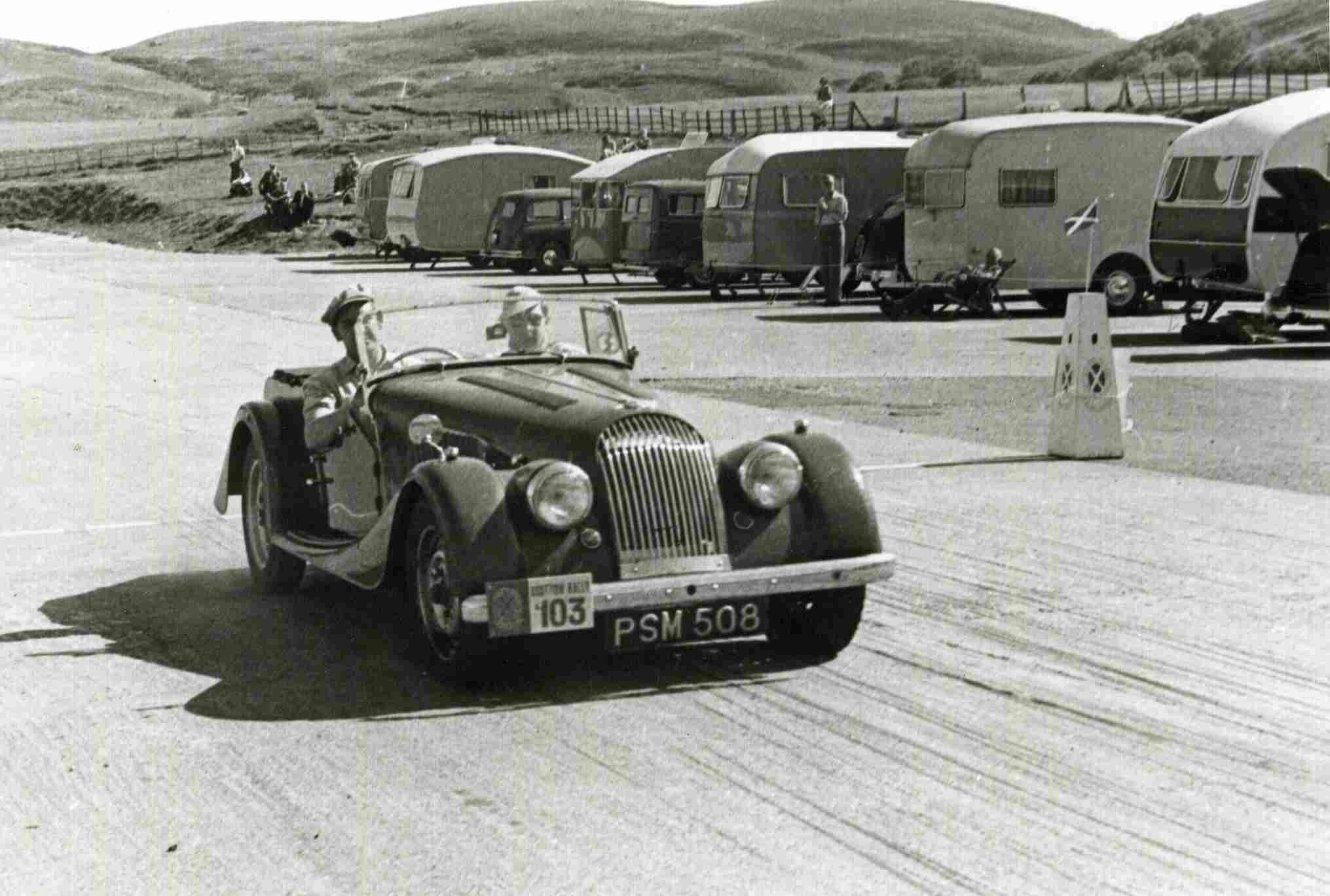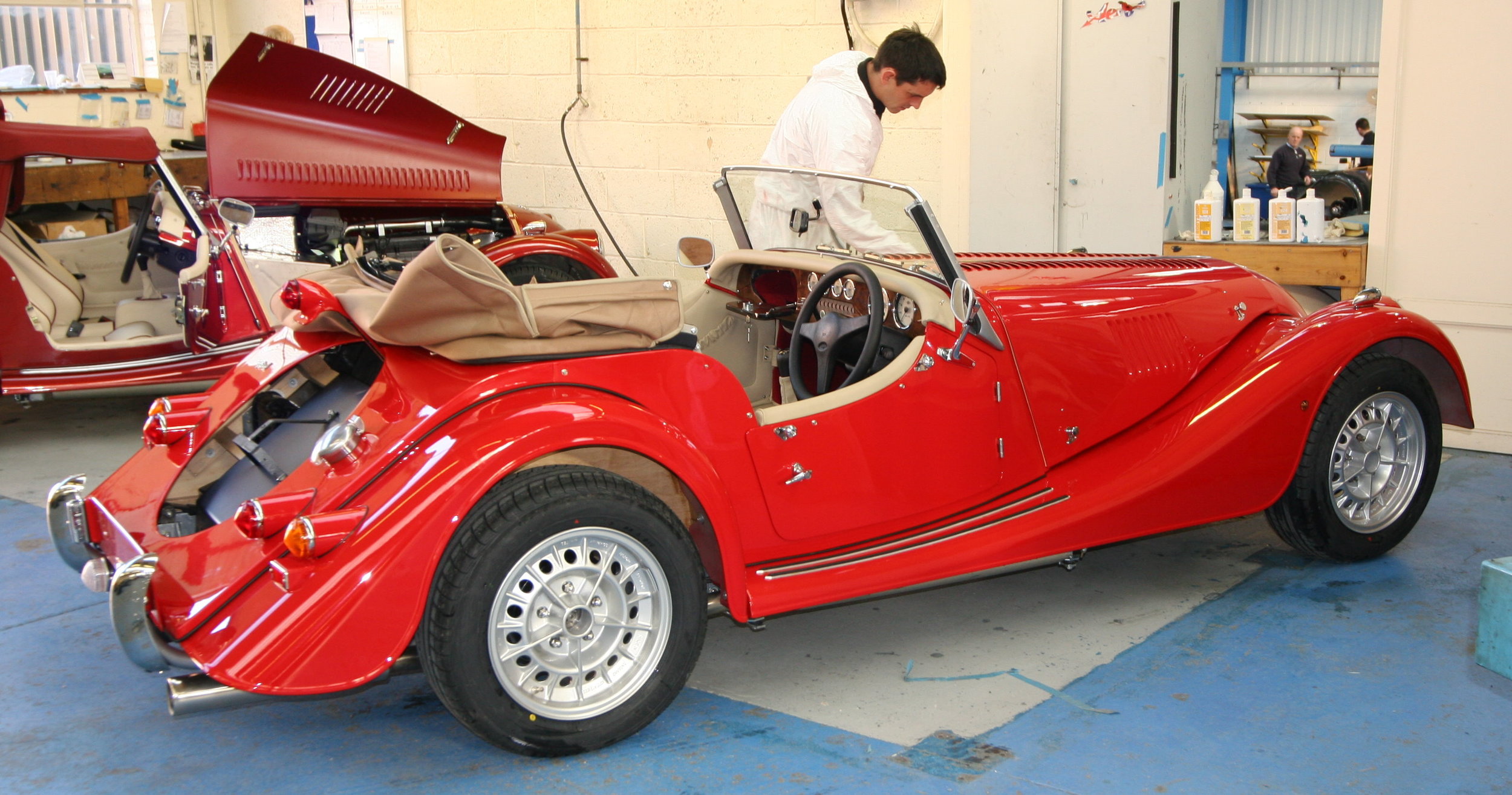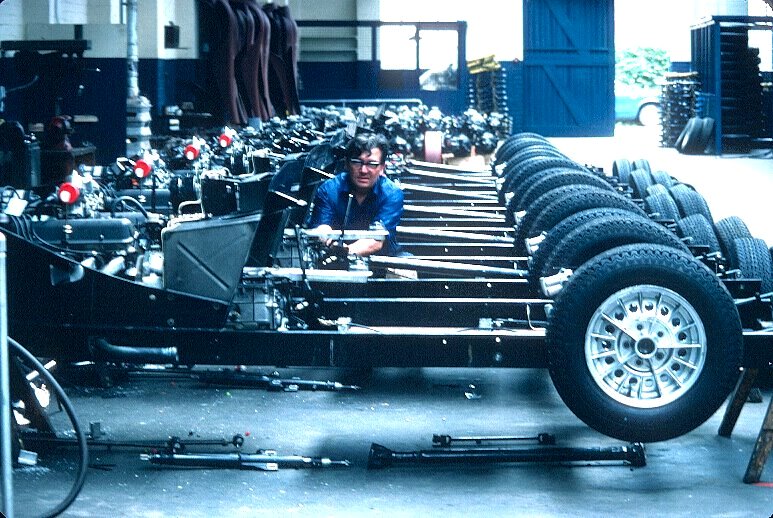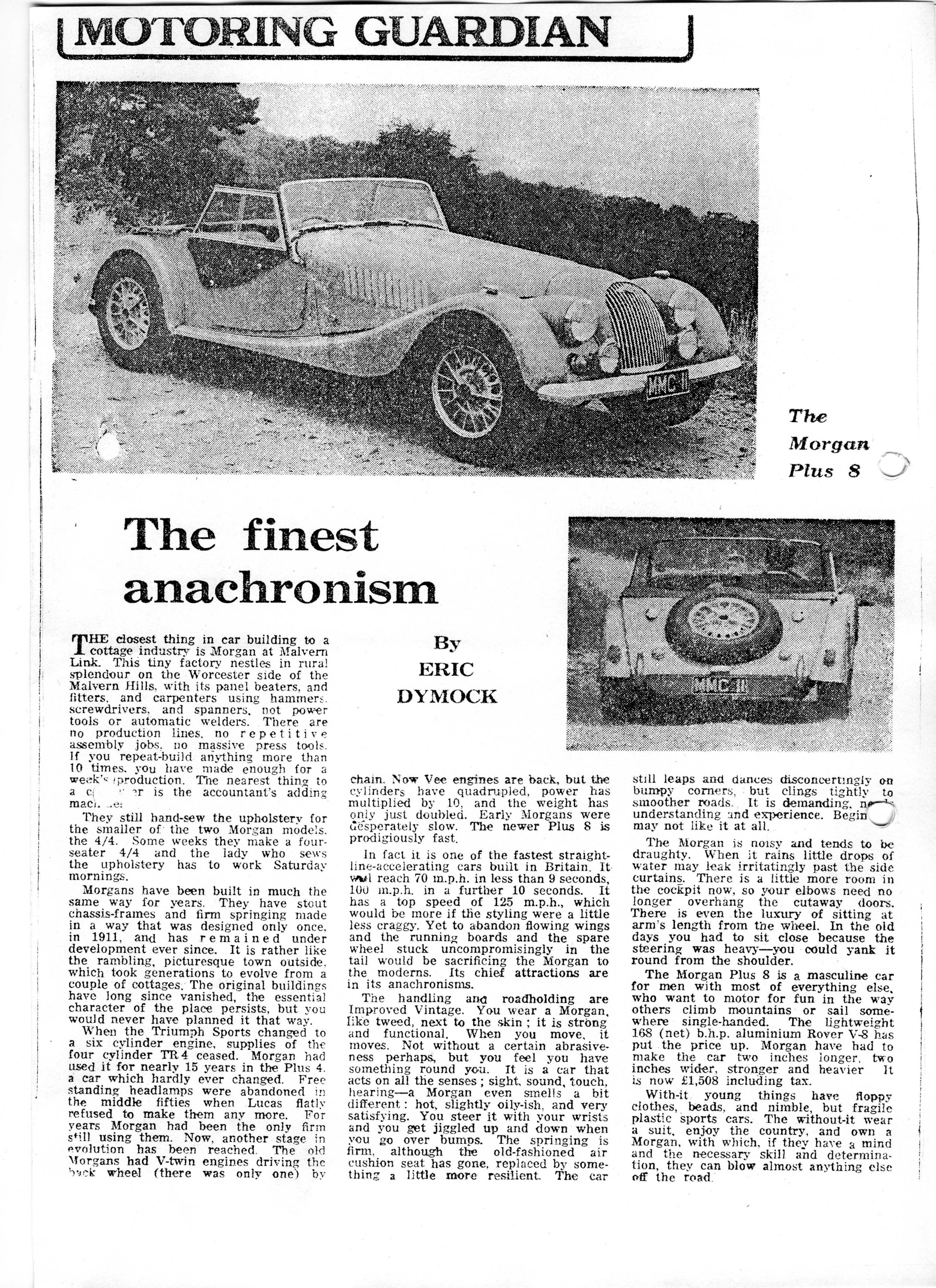The Guardian was maybe an unlikely medium for a sports car feature. In 1969 I had been its motor racing correspondent for three years, a contributor to its motoring column and now that Morgan has made its last V8, this is what I wrote about its first, when I drove MMC11. I drove to Malvern in a Vanden Plas Princess to try out the first demo Plus 8, along with Autocar columnist Eoin Young. Nowadays I don’t expect The Guardian, or me, for that matter, would write “a masculine car” any more. This was half a century ago.
This picture was a year later. On 25 August 1970 I went back in the Rolls-Royce 2-door Mulliner, to try out Plus 8 XAB998G, after reporting on the Oulton Park Gold Cup. Rolls-Royce registered any cars used by journalists 3500TU, or 100LG, so later owners would not suffer sharing them with, even retrospectively, press people. Also in the picture Craig Dymock, Sales Director of Carbonautica https://goo.gl/HPkNVX , aged two and a half, with his mother.
The Gold Cup in 1970 was a mixed Formula 1 and 5000 race won by John Surtees in Surtees-Ford TS7/001. The F1 entry was small but distinguished, Jochen Rindt in the Gold Leaf Team Lotus 72C/R2 finishing second, and Jackie Oliver with the Yardley BRM 153/04 third. Graham Hill drove a new Rob Walker Lotus 72C/R4 and Jackie Stewart the newly-revealed Tyrrell-Cosworth V8, his March 701/4 available as a stand-by. Stewart set fastest lap, breaking his own record established in a Matra on a track he loved.
Morgan and I went back a long way. Frank Dundas’s Plus 4 (below 1) was the first dyed-in-the-wool sports car I ever drove. I was familiar with MGs Triumph TR2s, even Austin-Healeys, yet they seemed almost effete against the harsh raw precision of the Morgan. Its Z-section chassis frame wasn’t very stiff. It flexed beneath you; you wore a Morgan like a shoe, as I write in the Guardian piece, when you move, it moves. And sliding pillar suspension didn’t have a lot of travel. I navigated Frank in rallies; there wasn’t much space for maps. In Blythswood Square Glasgow in fromt of the Royal Scottish Automobile Club (RSAC), I discuss with Chrissie Neil of the Lanarkshire Car Club. Next, the Scottish Rally 1955 driving tests on the concrete where wartime Coastal Command Sunderland flying boats were drawn up at Ganavan, near Oban. Frank was an accomplished driver. On the “Scottish” we were No 103, Billy Potts and Jim Clark were in Austin-Healey No 111 and we commissioned Bill Henderson to portray for our Jim Clark book a Rest-and-be-Thankful control presided over by AK Stevenson, secretary of the RSAC. Picture 4 is Morgan 3 wheelers, Charles Morgan’s 1935 Type F on the left with (right) a good view of sliding pillar suspension and the air-cooled V-twin.
Classic Cars magazine market watch on January 23 2019 saw “Morgans on the move: …but not all in the same direction.” Most classic Morgans from the 1930s to the 1980s have increased in value by around 30 per cent since its last price guide, though early 1950s Plus Fours have seen the least of that, moving by just 4.5 per cent. Rough examples, says Classic Cars, are up to £11k, usable ones at £18k and the best £26-38.5k. The scruffiest 4/4 of 1968-88 represents Morgan entry level at £7k and a perfect 1973-1986 Plus 8 tops out at £45k.
An early Plus 8 (1968-1972) is the exception, with prices fallen 12 per cent, meaning £14k for a rough one, £20k for something tidy and £32-50.5k for excellent. Accordingly an early 8 is still top of the pile and unlikely to change.
Hand-made Plus 8 and a 1973-1975 factory visit (above left) to drive Plus 8 Peter Morgan’s personal car judging from its British Monte Carlo Rally Competitors’ badge. Morgan didn’t have much of a production line – this row represents a week’s Plus 8s at the Pickersleigh Road factory, itself a piece of industrial archaeology. MOTORING GUARDIAN The finest anachronism:-
The closest thing in car building to a cottage industry is Morgan at Malvern Link. This tiny factory nestles in rural splendour on the Worcester side of the Malvern Hills, with its panel beaters, and fitters, and carpenters using hammers, screwdrivers, and spanners, not power tools or automatic welders. There are no production lines, no repetitive assembly jobs, no massive press tools. If you repeat-build anything more than 10 times, you have made enough for a week’s production. The nearest thing to a computer is the accountant’s adding machine.
They still hand-sew the upholstery for the smaller Morgan, the 4/4. Some weeks they make a four seat 4/4 and the lady who sews the upholstery has to work Saturday mornings.
Morgans have been built much the same way for years. They have stout chassis-frames and firm springing made in a way that was designed only once, in 1911, and has remained under development ever since. It is rather like the rambling, picturesque town outside, which took generations to evolve from a couple of cottages. The original buildings have long since vanished, the essential character of the place persists, but you would never have planned it that way.
When the Triumph Sports changed to a six cylinder engine, supplies of the 4-cylinder TR4 ceased. Morgan had used it for nearly 15 years in the Plus 4, a car that hardly ever changed. Free standing headlamps were abandoned in the 1950s when Lucas flatly refused to make any more. For years Morgan had been the only firm still using them. Now, another stage in evolution has been reached. The old Morgans had V-twin engines driving the back wheel (there was only one) by chain. Now Vee engines are back, but the cylinders have quadrupled, power multiplied by 10, and the weight has only just doubled. Early Morgans were desperately slow. The new Plus 8 is prodigiously fast.
In fact it is one of the fastest straight-line-accelerating cars built in Britain. It will reach 70 mph in less than 9 seconds, 100 mph in a further 10 seconds. It has a top speed of 125 mph, which would be more if the styling were a little less craggy. Yet to abandon flowing wings and running boards and the spare wheel stuck uncompromisingly in the tail would be sacrificing Morgan to the moderns. Its chief attractions are its anachronisms.
The handling and roadholding are Improved Vintage. You wear a Morgan, like tweed, next to the skin; it is strong and functional. When you move, it moves. Not without a certain abrasiveness perhaps, but you feel you have something round you. It is a car that acts on all the senses; sight, sound, touch, hearing—a Morgan even smells different: hot, slightly oilyish and very satisfying. You steer it with your wrists and get jiggled up and down over bumps. The springing is firm, although the old air cushion seat has gone, replaced by something more resilient. The car still leaps and dances disconcertingly on bumpy comers, but clings tightly to smooth roads. It is demanding, needs understanding and experience. Beginners may not like it at all.
Morgans are noisy and tend to be draughty. When it rains little drops of water leak irritatingly past the side curtains. There is a little more room in the cockpit now, so your elbows need no longer overhang the cutaway doors. There is even the luxury of sitting at arm’s length from the wheel. In the old days you had to sit close because steering was so heavy you had to yank it round from the shoulder.
The Plus 8 is a masculine car for men with most of everything else, who want to motor for fun in the way others climb mountains or sail somewhere single-handed. The lightweight 168 (net) bhp aluminium Rover V8 has put the price up. Morgan have had make the car two inches longer, two jinches wider, stronger and heavier. It is now £1,508 including tax.
With-it young things have floppy clothes, beads, and nimble, but fragile plastic sports cars. The without-it wear a suit, enjoy the country and own a Morgan, with which, if they have a mind and the necessary skill and determination, they can blow almost anything else off the road.
Morgan Plus 8 publicity picture.









